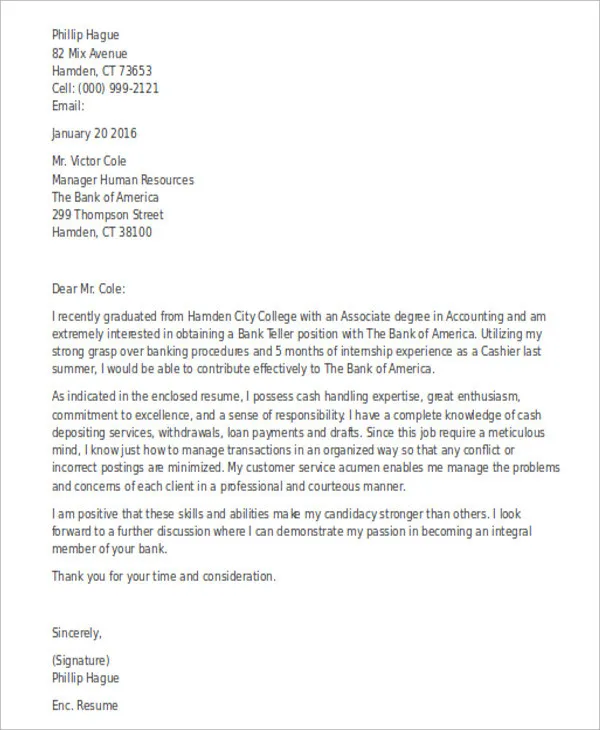Understanding the Bank Job Cover Letter
A bank job cover letter is a crucial document that accompanies your resume when applying for positions within the banking industry. It serves as your first introduction to potential employers, allowing you to showcase your qualifications, skills, and enthusiasm for the role. Unlike a resume, which provides a factual overview of your experience, a cover letter enables you to tell a compelling story about why you are the ideal candidate. It demonstrates your personality, communication skills, and your specific interest in the bank and the position you are applying for. A well-crafted cover letter can significantly increase your chances of landing an interview, while a poorly written one can lead to your application being overlooked. Therefore, understanding the purpose and importance of a bank job cover letter is the first step towards crafting a successful application.
Why a Great Cover Letter Matters
In the competitive world of banking, where numerous candidates possess similar qualifications, a great cover letter can set you apart. It provides an opportunity to highlight aspects of your profile that might not be immediately apparent from your resume. It allows you to articulate your career goals, demonstrate your knowledge of the banking industry, and express your genuine interest in the specific bank and role. A well-written cover letter showcases your writing skills, attention to detail, and professionalism, all of which are highly valued in the banking sector. It gives the hiring manager a glimpse of your personality and work ethic, helping them determine if you are a good fit for the company culture. Ultimately, a great cover letter is an investment in your career, increasing your chances of getting noticed and securing an interview.
Key Components of a Bank Job Cover Letter
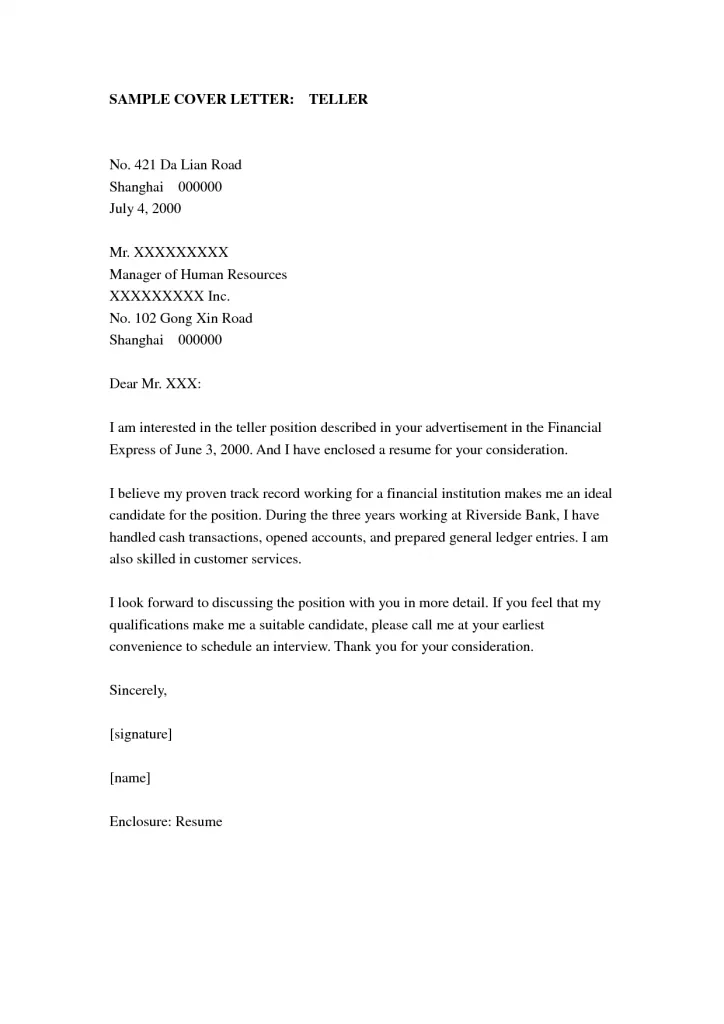
A bank job cover letter, like any professional document, has specific components that contribute to its overall effectiveness. Structuring your letter correctly ensures that you communicate your message clearly and comprehensively. These essential elements include a header with your contact information, a proper salutation, a compelling opening statement, detailed body paragraphs highlighting your skills and experience, a strong closing with a call to action, and a professional closing. Each part plays a crucial role in showcasing your qualifications, expressing your interest in the position, and demonstrating your suitability for the role. When drafting your cover letter, pay close attention to each of these sections to ensure that your application makes a positive and lasting impression on the hiring manager.
Header and Contact Information
The header of your bank job cover letter is the first thing a hiring manager will see, making it critical to present your information clearly and professionally. Begin by including your full name, address, phone number, and email address. Make sure your email address sounds professional. Below your contact details, include the date and the hiring manager’s name, title, and the bank’s address. If the hiring manager’s name is not available, use a general salutation like ‘Dear Hiring Manager.’ The header should be well-formatted, with consistent font and spacing, ensuring that your contact information is easy to find and read. This ensures the recruiter can easily contact you for an interview.
The Salutation Properly
The salutation sets the tone for your entire cover letter. If possible, address the hiring manager by name; this shows that you’ve done your research and are genuinely interested in the position. Use ‘Dear Mr./Ms./Mx. [Last Name]’ and ensure you spell their name correctly. If you cannot find the hiring manager’s name, a general salutation such as ‘Dear Hiring Manager’ or ‘Dear [Bank Name] Hiring Team’ is acceptable. Avoid using generic salutations like ‘To Whom It May Concern,’ which can make your letter seem impersonal. The salutation should be followed by a colon. The correct salutation is essential for creating a positive first impression, signaling respect, and demonstrating your attention to detail, all important qualities for a banking professional.
Crafting a Strong Opening Statement
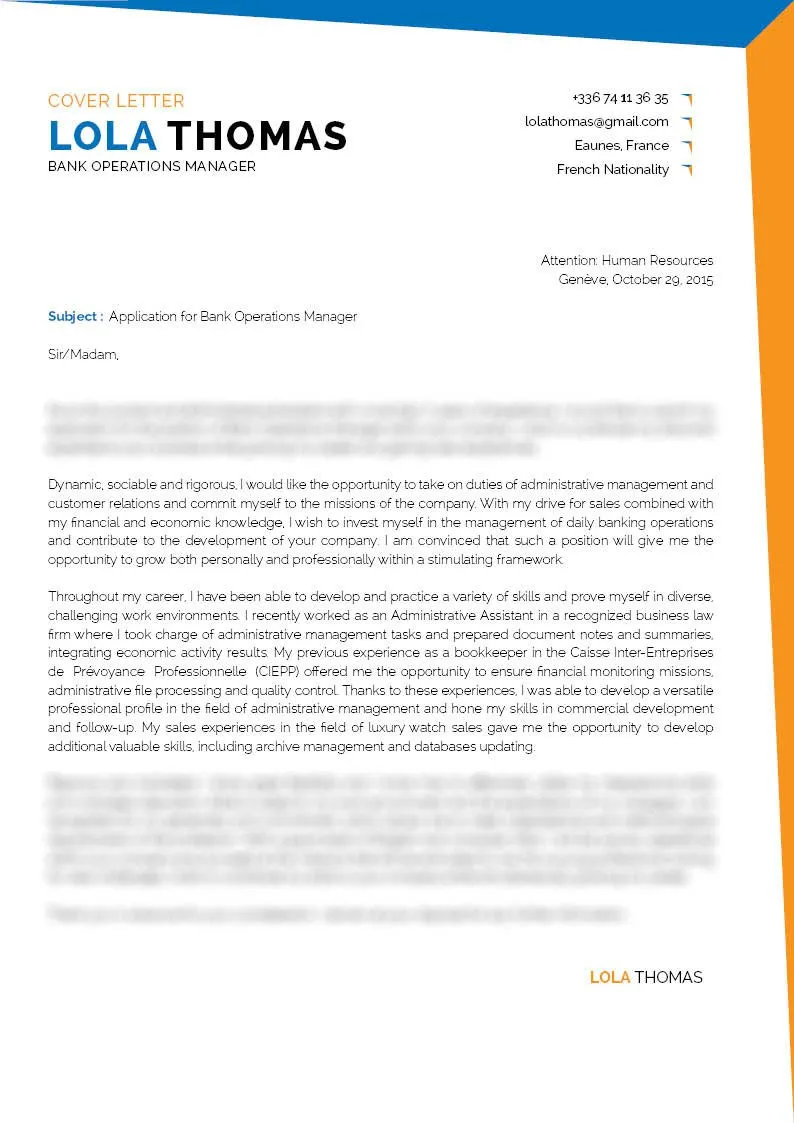
Your opening statement is your opportunity to grab the hiring manager’s attention and set the tone for the rest of your cover letter. Start by clearly stating the position you are applying for and how you found the opportunity. Briefly mention why you are interested in the role and the bank, demonstrating your enthusiasm. You can also include a brief highlight of your key qualifications or a compelling achievement that immediately showcases your suitability. The opening should be concise and engaging, drawing the reader in and making them want to continue reading. Avoid generic phrases and instead focus on a statement that shows your unique value proposition and your understanding of the bank’s needs. A strong opening statement ensures your cover letter stands out from the numerous other applications a hiring manager receives.
Highlighting Relevant Skills and Experience
The body of your cover letter is where you elaborate on your skills and experience, demonstrating why you are a good fit for the bank job. Focus on the skills and experiences most relevant to the position. Carefully review the job description and identify the key requirements. Provide specific examples of how you have demonstrated these skills in previous roles or experiences. Use the STAR method (Situation, Task, Action, Result) to structure your examples, making them clear and impactful. Quantify your achievements whenever possible to illustrate the impact you’ve made, such as ‘Increased sales by 15%’ or ‘Managed a budget of $X’. Tailor your descriptions to the specific requirements of the role. Use keywords from the job description naturally to showcase your understanding and qualifications.
Quantifying Achievements for Impact
Quantifying your achievements in your bank job cover letter is crucial to demonstrate the tangible impact of your skills and experience. Instead of simply stating that you have experience in a particular area, use numbers and data to illustrate your accomplishments. For instance, instead of saying ‘Improved customer service,’ write ‘Improved customer satisfaction scores by 20% through implementation of a new training program.’ Use metrics like percentages, dollar amounts, and time frames to showcase your accomplishments. This approach gives the hiring manager a clear picture of your capabilities and the value you can bring to the role. Quantifiable achievements also make your claims more credible and help differentiate you from other candidates. By providing concrete evidence of your past successes, you build a strong case for your ability to perform well in the bank job.
Tailoring Your Letter to the Job
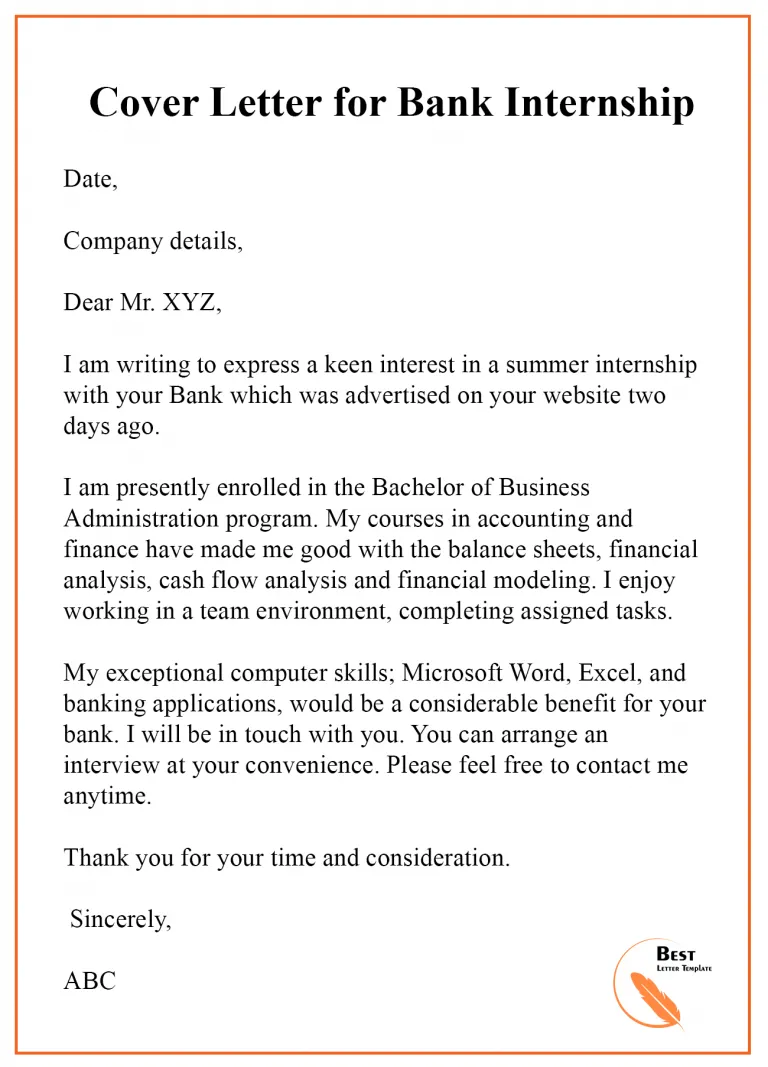
Tailoring your bank job cover letter to the specific job and bank is critical to demonstrating your genuine interest and suitability. Avoid using generic templates; instead, customize your letter for each position you apply for. Start by thoroughly reviewing the job description, identifying the key requirements and skills. Then, in your cover letter, explicitly address these requirements, providing examples of how your experience aligns with them. Research the bank; understand its mission, values, and recent developments. Show how your skills and experience align with the bank’s objectives. Mention specific aspects of the bank that appeal to you and explain how you can contribute to their success. This level of personalization shows that you have put in the effort and are truly interested in the specific role and the bank, greatly increasing your chances of getting an interview.
Showcasing Your Understanding of the Bank
Demonstrating your understanding of the bank is a powerful way to impress a hiring manager and showcase your genuine interest in the position. Research the bank’s history, values, and current strategic initiatives. Visit their website, read their annual reports, and follow their social media presence to gain insights into their culture and operations. In your cover letter, mention specific aspects of the bank that resonate with you, such as their commitment to customer service, community involvement, or innovative financial products. Explain how your values align with the bank’s mission and how you can contribute to their goals. Mention any recent news or achievements related to the bank to demonstrate your awareness and interest. Showing this level of understanding proves that you have taken the initiative to learn about the bank, which can significantly strengthen your application.
The Closing and Call to Action
The closing of your bank job cover letter should be professional and leave a positive lasting impression. Thank the hiring manager for their time and consideration. Reiterate your interest in the position and the bank. Include a strong call to action, such as requesting an interview or stating your availability for a discussion. Express your enthusiasm and reiterate your qualifications. Ensure your closing is polite and professional, using phrases like ‘Sincerely,’ ‘Best regards,’ or ‘Thank you for your consideration.’ End with your full name, making it easy for the hiring manager to identify you. A well-crafted closing ensures you leave a lasting impression, clearly states your intentions, and encourages the hiring manager to take the next step in the hiring process. Proper closing strengthens the impact of your application.
Proofreading and Editing Your Letter

Proofreading and editing your bank job cover letter are crucial steps to ensure it presents you in the best possible light. Errors in grammar, spelling, and punctuation can undermine your credibility and make you appear unprofessional. Read your cover letter multiple times, carefully checking for any mistakes. Use spell-check and grammar-check tools, but do not rely on them completely; these tools may miss subtle errors. Ask a friend, family member, or career advisor to review your letter. Fresh eyes can often spot errors that you might have overlooked. Ensure the formatting is consistent, the font is professional, and the spacing is correct. Proofreading also involves checking the content for clarity, conciseness, and relevance. Make sure your message is clear and that your skills and experience align with the job requirements. A polished cover letter demonstrates your attention to detail and commitment to excellence, boosting your chances of getting noticed.
Common Mistakes to Avoid
Several common mistakes can significantly decrease the effectiveness of your bank job cover letter. Avoid using generic templates without customizing them to the specific job and bank. Do not include irrelevant information or repeat your resume verbatim; the cover letter should complement the resume, providing more detailed information. Avoid spelling and grammatical errors at all costs; these errors indicate a lack of attention to detail. Do not be overly formal or use jargon that might confuse the reader. Avoid negative language or complaining about previous employers. Avoid exaggerating or providing false information. Failing to proofread your letter is a significant mistake. Finally, do not forget to include a call to action. By avoiding these common pitfalls, you can create a cover letter that enhances your candidacy and maximizes your chances of success.
Formatting and Design Tips
The formatting and design of your bank job cover letter play a crucial role in how it is perceived. Use a professional and easy-to-read font like Times New Roman, Arial, or Calibri, with a font size between 10 and 12 points. Maintain consistent formatting throughout the document, including spacing, margins, and alignment. Use a standard letter format with a clear header containing your contact information, the date, and the recipient’s details. Keep the letter concise and well-organized, with clear paragraphs and headings. Avoid using excessive bolding, underlining, or italics, which can make the letter appear cluttered. Ensure the letter is well-structured, with a strong opening, body paragraphs, and a clear closing. Consider using bullet points to highlight key skills or achievements. Clean formatting and design demonstrate your professionalism and make your cover letter easy to read, increasing the likelihood that the hiring manager will review it carefully.
Bank Job Cover Letter Samples and Templates
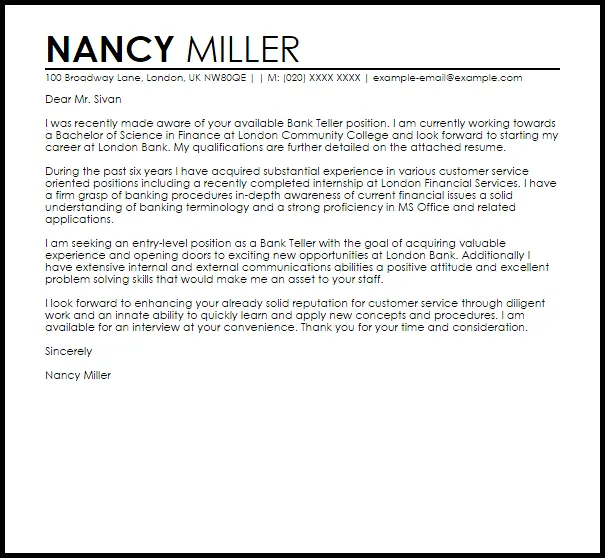
Using bank job cover letter samples and templates can be a helpful starting point when writing your own letter. These resources provide examples of well-written cover letters that you can adapt to your specific needs and experience. Look for samples that are tailored to the specific role you are applying for, such as a bank teller, loan officer, or financial analyst position. Examine the structure, language, and tone of the samples to get ideas for your own letter. However, avoid simply copying and pasting a template. Instead, use the samples as a guide and customize them to reflect your unique skills, experience, and the requirements of the job. Adapt the language to your voice, highlighting your relevant achievements and tailoring the content to the bank’s needs. Remember, the goal is to create a cover letter that stands out and showcases your individuality, rather than a generic copy. Carefully review and modify any template to ensure it accurately represents you.
